Would it be too much of a hot take to say that everything Avengers: Infinity War and Avengers: Endgame did, the fifth and final season of She-Ra And The Princesses Of Power did just as well – if not better in several instances? I’ll let you decide.
Now, to be fair, She-Ra has the advantage of being a Netflix series, with up to thirteen-episode seasons, so it’s probably not entirely right to compare it to any movie, even ones that are three hours long. However, considering that She-Ra‘s final season, whether intentionally or coincidentally, lifts a great deal of material straight from the closing chapters of the Infinity Saga, it seems fair enough to compare the two storylines, and how they are executed, and how the Netflix/Dreamworks cartoon sometimes gets it right where the Marvel Studios blockbusters falter.
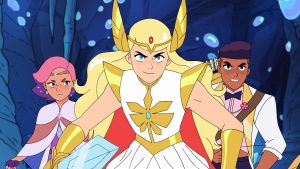
But first, a little background. I was not a She-Ra fan until Friday morning, when I decided it was high time I watched the entire series as quickly as possible, in order to catch up with the final season which had just dropped on Netflix. I had tried once before, several months ago, but I never even got past the opening credits. I forced myself through on this occasion, however – and before the first episode was over, I was already very thankful for that decision, because….wow. But don’t even get me started on the four previous seasons. This is strictly a Season 5 review.
Though I do think a little bit of Season 4 finale recap is in order – if you haven’t caught up, be warned: SPOILERS for that season up ahead! In the aftermath of Queen Glimmer (Karen Fukuhara) recklessly deciding to use the Heart of Etheria – a magical superweapon which lies embedded deep within the core of the planet – a great many things have changed in the status quo: first of all, Etheria itself has been carried through a portal out of its empty pocket-dimension and back into the larger universe; Adora (Aimee Carrero) has lost her connection with the ancient warrior She-Ra, and the Sword of She-Ra is broken and useless; and Hordak (Keston John), once the greatest enemy of the Princesses of Power, has been revealed to be nothing more than the puppet and defective clone of a far greater evil – Horde Prime (also Keston John), an alien overlord who has now launched a massive invasion of Etheria, and has simultaneously captured Glimmer, Hordak, and Hordak’s former second-in-command, Catra (AJ Michalka).

Season 5 picks up after a small time jump. Horde Prime’s invasion is well underway now, and Adora, the archer Bow (Marcus Scribner), and all the remaining Princesses of Power are leading a futile rebellion against him. But on Horde Prime’s flagship, Glimmer and Catra are forced to establish a delicate trust bond with Prime and with each other as they plot a way to escape from imprisonment. Prime is essentially Thanos, and with less clever writing he might just have been that: his agenda (to destroy worlds across the universe in order to achieve cosmic balance and bring about a lasting peace) is much like the Mad Titan’s plan to end world hunger by wiping out half of every planet’s population; even more specifically, he too is the long-awaited mastermind behind the plans of an earlier antagonist in the franchise, who arrives on a gargantuan starship from the depths of space, whose army of mindless bodyguards start almost all their speeches with the word “Rejoice”, and who also has a tendency to meaningfully snap his fingers. Like Thanos, he has arrived on Etheria with the intention of claiming a superweapon that just so happens to come in the form of a magical link between a set of multi-colored crystals.
But unlike Thanos, Horde Prime has time to elaborate on his plans, and the characters have time to get to know him, to witness firsthand his strengths, and to begin to understand his weaknesses while they wander his ship. His special abilities, cloning and mind-control, aren’t anything we haven’t seen before, but they do also differentiate him from Thanos. And in one of my favorite scenes from early in the series, we get a chilling look at the devastation Horde Prime has wrought when he serves Glimmer and Catra a dinner consisting of various rare delicacies from worlds he destroyed in the past. Being the last person in the universe to know an entire planet’s recipes may not seem too dramatic, but it instantly makes the fight to save Etheria more personal, and conveys the horrors of Horde Prime’s conquests far better than any war-torn planet or battlefield.
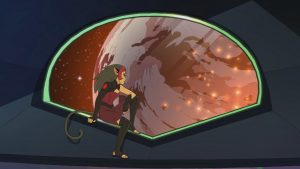
And that’s the thing: whenever She-Ra strays dangerously close to imitating the Marvel films, it immediately veers away again with the help of some clever, quirky twist that makes it feel fresh and invigorating. The final season may have all the same scope, scale and – occasionally – story-beats as Endgame, but it puts its own unique spin on that story. There is only one instance I can think of where this isn’t the case, when several of our heroes (I won’t say which) are left stranded in space on their way to Etheria, but the fuel they need for their own ship is actually crystals in the exact shape of Captain Marvel’s eight-pointed star – Captain Marvel being the one who rescued Tony Stark from being stranded in space after his ship ran out of fuel – so they touch down on a desolate planet only to run into a motley crew of space pirates led by a woman called Starla (Melissa Fumero) and a bald purple cyborg woman with trust issues, in an interaction that plays out almost identically to a similar meeting between Tony Stark and Star Lord’s motley crew of space pirates – which also includes a bald purple cyborg woman with trust issues – in Avengers: Infinity War.
But there’s a not-so-secret weapon at the heart of She-Ra, and that’s the series’ core cast of characters and the relationships between them, which are constantly evolving in new, unpredictable directions. Avengers: Infinity War‘s greatest problem, in my opinion, is how it sacrificed character for plot: it’s a problem that unfortunately carries over into parts of Endgame – but She-Ra doesn’t have that problem: every major character has room to grow, and all their development happens onscreen, so it doesn’t need to be exposited to the audience. The cast is also small enough already that everyone can get a meaningful role: whereas in Endgame, it sometimes felt like certain characters had only survived the Infinity War snap so they could provide comedic relief.
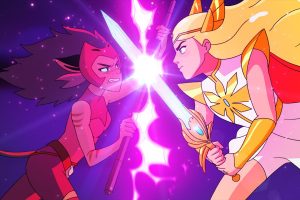
The story’s focus is still on Adora and Catra, as the couple navigates their fragile relationship with some difficulty. But for the first time, it’s not Adora putting in all the effort: Catra, for her part, is finally trying to stop pushing people away from her every time they show her any affection – though, much like Marvel’s Loki, she still plans on exploiting the current chaos for her own advantage, even if it means hurting others. Their relationship goes through some very surprising ups-and-downs this season. Separately, they’ve both changed as well – Adora is busy over-exerting herself as she tries to match the strength and stamina she possessed when she could turn into She-Ra, while Catra is a quieter, less aggressive shadow of her former self.
Catra’s reluctant interactions with the imprisoned Queen Glimmer are also surprisingly fun to watch, as Glimmer too has to make an effort to trust her former enemy, the woman responsible for her own mother’s death. Glimmer has had a rough time these past couple of seasons, losing people she loves and watching as her close circle of friends gives up on her when she needs them most – something which is partly her own fault, as her stubbornness manifests itself in increasingly dangerous decisions. Much like Catra, she is descending into a dark place, and it’s both thrilling and scary to join her on that journey.
Back on Etheria, Bow has also made some changes to his own lifestyle – though not quite enough to make him give up crop-tops, which he still wears proudly even in circumstances where one would think it impossible: such as the crushing void of space. His arc in this season is more understated than others, but it gives him a number of deeply satisfying revelations about his purpose in life, and also briefly reunites him with his two dads, who are still just as charming and witty as ever.
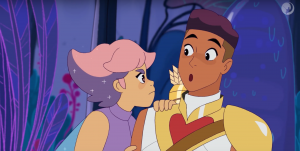
My personal favorite character in the series, the geeky tech-genius Entrapta (Christine Woods), is given plenty of material to work with (quite literally) this season. Lost and lonely without her lab partner Hordak to turn to, she once again has a hard time reminding herself that she can’t just join the bad guys because they have cooler technology.
The other Princesses each get more time to shine, especially now that She-Ra herself isn’t around to steal the spotlight from them in action sequences. Shy, sensitive Scorpia (Lauren Ash), having just recently regained her Princess status after living her entire life severed from the powers of her Runestone, is the most compelling to watch – but then, she’s always been compelling. To no one’s surprise, she gravitates most toward Princess Perfuma (Genesis Rodriguez), who is battling her own insecurities and finds a kindred spirit in Scorpia’s gentle personality. The two more brusque Princesses, Frosta (Merit Leighton) and Mermista (Vella Lovell) have smaller roles this season: though the latter does get some very interesting development later in the season, and, as always, has adorable banter with the boisterous pirate captain, Sea Hawk (Jordan Fisher). A pleasant surprise is the upgrade of guest stars Spinnerella (Noelle Stevenson) and Netossa (Krystal Joy Brown) to recurring characters: they’ve come a long way from the time when Bow couldn’t even remember what their powers were.
Several villains find themselves joining with the Rebellion against Horde Prime’s power – the Horde itself has dissolved, while Hordak is trapped between his loyalty to his maker, and fidelity to his friend Entrapta (is there something more to their peculiar relationship? You’ll just have to watch and find out). Shadow Weaver (Lorraine Toussaint), meanwhile, still maintains that she is loyal to Queen Glimmer, even though her meddling with dark magic, which resumes early in the season as the Rebellion runs out of other options, makes her vulnerable to the temptation of evil.
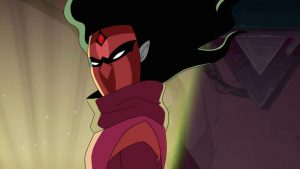
The dark magic itself is still fairly vague, but it is used in a greater capacity than ever before, and there are several fights which utilize it very well – especially those which also involve Glimmer’s father Micah (Daniel Dae Kim), who has had a little time to regain his strength since his decades-long sojourn on Beast Island. All in all, the action has been upgraded significantly this season: in particular, the fight scene which closes out Episode 5 is appropriately epic, and another fight soon after has one character literally leaping across an asteroid belt and blowing up starships with their bare hands. That’s all thanks to the incredible animation, of course.
A She-Ra review wouldn’t be complete without a shout-out to the series’ commitment to diversity – an area in which it wipes the floor with Endgame. While that film mustered up one nameless gay background character, She-Ra ends queerbaiting critiques once and for all with definitive, powerful LGBTQ+ representation.
For me, She-Ra beats out Endgame because of how undeniably right the payoff for every story thread and character arc is in the end. While Endgame leaves room for argument and debate over several characters’ fates, She-Ra ties everything up neatly, in a way that is brave but satisfying – at least for me. There’s no room for the sort of unending, roundabout discourse that plagues other fandoms. This feels like a conclusive, fitting ending for characters I only just met yesterday and for whom I would already sacrifice everything.
Series Rating: 10/10